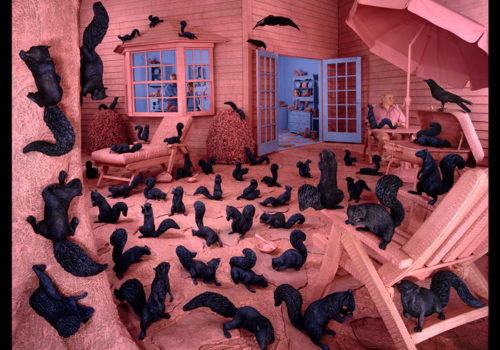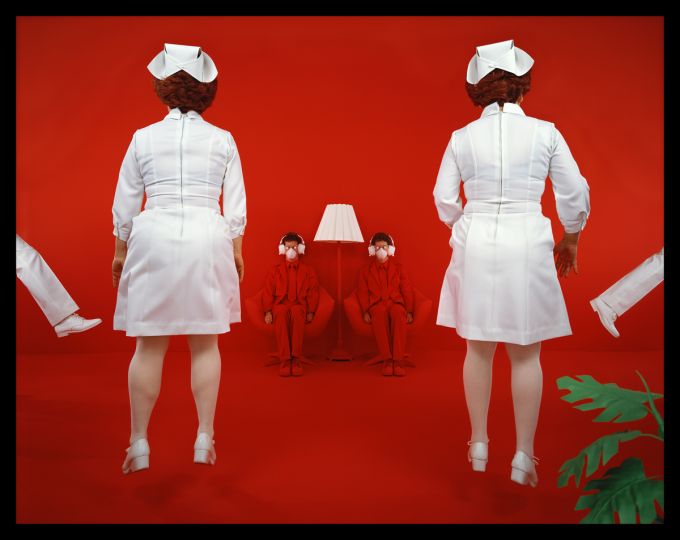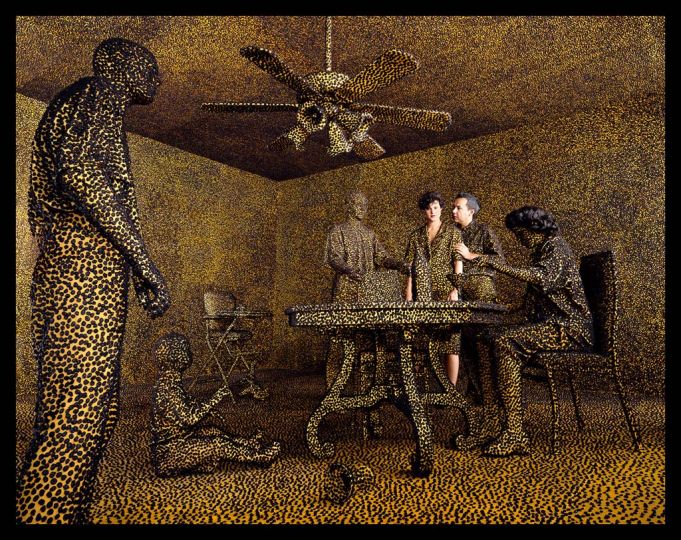Sandy Skoglund was born in Weymouth, Massachusetts (USA) in 1946. She studied studio art and art history at Smith College in Northampton, Massachusetts from 1964 – 68. Skoglund went to graduate school at the University of Iowa in 1969 where she studied filmmaking, intaglio printmaking, and multimedia art, receiving her M.A. in 1971 and her M.F.A. in painting in 1972. She moved to New York City in 1972, where she started working as a conceptual artist, dealing with repetitive, process-oriented art production through the techniques of mark making and photocopying. In the late 1970s Skoglund’s desire to document conceptual ideas led her to teach herself photography. This resulted in the kind of “staged photography” that other artists became involved with starting in the 1980s such as Cindy Sherman and David LaChapelle. This was a larger result of an interest in popular culture and commercial picture making strategies, resulting in the directorial tableau work Skoglund is known for today.
Skoglund bridges the boundaries between sculpture, installation art, and photography having become renowned for her large format photographs of the original impermanent installations. She has often exhibited in solo shows of installations and photographs as well group shows of photography. Her work is currently included in such esteemed institutions as the Brooklyn Museum, the Centre Georges Pompidou, the Chicago Art Institute, the Los Angeles Country Museum of Art, the Metropolitan Museum of Art in New York, and the Whitney Museum in New York. She is a recipient of the Koopman Distinguished Chair in the Visual Arts for Hartford Art School, the Trustees Award for Excellence from Rutgers University, the New York State Foundation for the Arts individual grant, and the National Endowment for the Arts individual grant. Skoglund currently lives in Jersey City, New Jersey.
Your work is multi-dimensional and has layers of meaning. Would you mind explaining the meaning behind a couple of pictures? Let’s take Dogs on the Beach and The Wedding, two works in the collection of Holden Luntz Gallery.
I believe that the meaning of making art in today’s complex world is simply in actually doing it. Many people imagine things, but fewer carry them out. Other than that, there is only the meaning that can be inferred from the activity of doing the work and from the final image.
With Dogs On the Beach, I loved the strangeness of taking the dog sculptures that I had made for another work (The Green House) and putting them in another context. I was interested to see how all the dogs would affect the beach. It was also an experiment in working very quickly, since the whole project had to be carried out in one day. I took the picture in the spring season, so the weather was cool and windy.
I think of The Wedding as an elaborate celebration, a hopeful commitment to a better life lived together rather than apart. The grey flowers are made of ceramic stoneware clay, each one made by hand. In this sculptural repetition, the idea of time and labor is included in the process. This piece took about a year to create.
The grey color of the ceramic flowers makes them seem like rocks and stones that have sprung briefly to life on the fleeting landscape of love. Sticky and gooey materials like jam and marmalade cover the walls and floor. In the midst of this sticky substance, two people walk toward each other in the shadow of a wedding cake that has been painted red. The cake is like a giant sentinel, a witness to this event, this poignant human desire for everlasting permanence.
Due to the deterioration of the jam and marmalade, this installation no longer exists, except for the ceramic roses left behind.
Food and animals have been basic components in much of your work. Why? Is there a social dimension to these elements?
I think of Food as a universal language. Everyone eats. For the camera, food has colors and textures that can be manipulated to fabulous effect. I love the childish behavior of sculpting and painting with food. Food as a material allows me to explore the boundaries between nature and artifice. The way I work with food allows me to stretch the edges of expectations.
Humans are part of the animal family. In my works with animals, I like to ask: who is looking at whom? I am especially interested in exploring consciousness as seen from a non-human perspective. Animal life presents people with a relief from themselves.
Repetition is also quite present in your photographs; Cheetos, Goldfish, glasses of wine, etc. are seen filling the space. Is there a message in this multiplicity of objects?
I think repetition is beautiful but it can also be unsettling. It can be used to create visual patterns that are astonishing to the eye. In American consumer culture, repetition is often used to display abundance and availability. The main visual effect of a supermarket or big box store is blizzard-like with patterning from the multiple arrays of objects. When taken to extremes, the flip side of repetition can be scary and overwhelming. Repetition is also a comfort to the mind, which likes to experience familiarity. And finally, repetition is exactly that: each element that is repeated is different. Each glass of wine is different, just as each snowflake is different. Repetition allows us to sharpen our senses to the small differences.
Do you work collaboratively building the sets for your pictures? If so, how do you balance having assistants and implementing your own individual vision?
Sometimes I work with assistants and sometimes I do not. My ideas are what count for me, and I am grateful to have anyone around who can help me carry them out.
Though the final product of your work is a two-dimensional picture, it is based in a constructed, three-dimensional setting. How do you plan for a three-dimensional world to be effectively communicated in two dimensions?
The best way to plan for a two-dimensional outcome is to create a solid three dimensional beginning. Once you have the world, then you can photograph it.
This interview is part of a series conducted by Holden Luntz Gallery, based in Palm Beach, Florida.
Interviewer: Sara Tasini
Holden Luntz Gallery
332 Worth Ave
Palm Beach, FL 33480
USA


















